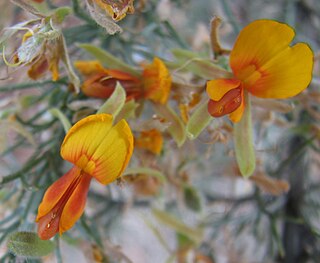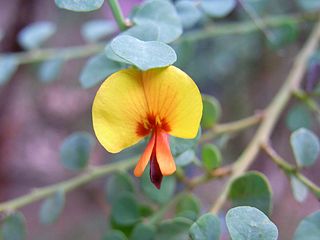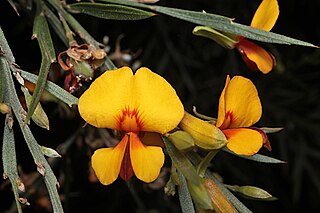
Jacksonia furcellata, commonly known as grey stinkwood, is a species of flowering plant in the family Fabaceae and is endemic to the south-west of Western Australia. It is a prostrate to low-lying, or weeping erect shrub with greyish-green branches, sharply-pointed side branches, its leaves reduced to scales leaves, yellowish-orange flowers, and woody, hairy pods.

Jacksonia sericea, commonly known as waldjumi, is a species of flowering plant in the family Fabaceae and is endemic to the south-west of Western Australia. It is a spreading to prostrate shrub with greyish-green branches, straight, sharply-pointed side branches, leaves reduced to scales, orange flowers with red markings, and woody, densely hairy pods.

Daviesia ulicifolia, commonly known as gorse bitter-pea, is a species of flowering plant in the family Fabaceae and is endemic to south-eastern Australia. It is a rigid, openly-branched shrub with sharply-pointed, narrow elliptic, narrow egg-shaped, rarely egg-shaped phyllodes and usually orange-yellow and dark red flowers.

Bossiaea rhombifolia, is a species of flowering plant in the family Fabaceae and is endemic to eastern Australia. It is an erect, glabrous shrub with diamond-shaped, more or less round or broadly egg-shaped leaves, and yellow and red or pinkish flowers.
Micromyrtus greeniana is a species of flowering plant in the myrtle family, Myrtaceae and is endemic to a small area in the west of Western Australia. It is a spindly shrub with linear to egg-shaped leaves and small white or cream-coloured flowers.

Jacksonia lehmannii is a is a species of flowering plant in the family Fabaceae and is endemic to the south-west of Western Australia. It is an erect to prostrate or spreading, spindly shrub with greyish-green branches, sharply-pointed side branches, its leaves reduced to scales leaves, yellowish-orange flowers with orange-red markings, and woody, hairy pods.

Jacksonia horrida is a species of flowering plant in the family Fabaceae and is endemic to the south-west of Western Australia. It is an erect or spreading to prostrate, bushy shrub with greyish-green branches ending in short, flattened, sharply-pointed side branches, the leaves reduced to scales and the flowers scattered and yellow-orange with red markings.
Pultenaea craigiana is a species of flowering plant in the family Fabaceae and is endemic to near Ravensthorpe in the south of Western Australia. It is an erect, spindly shrub with densely hairy young stems, egg-shaped leaves with the narrower end towards the base, and yellow and red flowers.

Jacksonia anthoclada is a species of flowering plant in the family Fabaceae and is endemic to the south-west of Western Australia. It is an erect, single-stemmed shrub with hairy, elliptic to egg-shaped phylloclades with sharply-pointed edges, yellow-orange flowers with red markings, and hairy, woody pods.

Daviesia grahamii is a species of flowering plant in the family Fabaceae and is endemic to the interior of Western Australia. It is a multi-stemmed shrub with narrowly egg-shaped to linear phyllodes, and bright yellow to orange-yellow, dark red and maroon flowers.
Stenanthemum limitatum is a species of flowering plant in the family Rhamnaceae and is endemic to the southwest of Western Australia. It is an erect or straggling shrub with sparsely hairy young stems, egg-shaped to fan-shaped leaves and greyish, softly-hairy heads of white or cream-coloured flowers.

Jacksonia acicularis is a species of flowering plant in the family Fabaceae and is endemic to the west of Western Australia. It is an erect, spindly shrub with very sharply-pointed short side branches, leaves reduced to scales, orange flowers with red markings, and densely hairy pods.

Jacksonia aculeata is a species of flowering plant in the family Fabaceae and is endemic to the northern Australia. It is a spreading shrub with sharply-pointed, hairy, short side branches, leaves reduced to scales, lemon-yellow flowers, and woody, hairy pods.

Jacksonia alata is a species of flowering plant in the family Fabaceae and is endemic to the south-west of Western Australia. It is a tufted, semi-prostrate to erect shrub with flattened branches, sharply-pointed side branches or phylloclades, leaves reduced to narrowly lance-shaped scales, yellow-orange flowers with a red "eye", and woody, densely hairy pods.

Jacksonia angulata is a species of flowering plant in the family Fabaceae and is endemic to the south-west of Western Australia. It is a tufted, spreading to prostrate shrub often with zig-zagged branches, sharply-pointed side branches or phylloclades, leaves reduced to broadly egg-shaped scales, yellow-orange to orange flowers with a red "eye", and woody, densely hairy pods.

Jacksonia arenicola is a species of flowering plant in the family Fabaceae and is endemic to the south-west of Western Australia. It is an erect, broom-like shrub with densely hairy, sharply-pointed phylloclades, yellow-orange flowers with red markings, and woody pods that are hairy at first, later glabrous.

Jacksonia argentea is a species of flowering plant in the family Fabaceae and is endemic to the far north of Western Australia. It is an erect, silver-grey shrub with flattened, narrowly lance-shaped to narrowly elliptical cladodes or phylloclades, bright yellow flowers, and woody hairy pods.
Jacksonia arida is a species of flowering plant in the family Fabaceae and is endemic to Western Australia. It is an erect or prostrate shrub with tangled branches, sharply-pointed branchlets, yellow-orange to orange flowers, and woody pods.

Jacksonia calcicola is a species of flowering plant in the family Fabaceae and is endemic to the south west of Western Australia. It is a prostrate spreading or erect, prickly shrub with short, curved backwards and sharply pointed end branches, yellow-orange flowers with red markings, and woody, hairy pods.
Jacksonia calycina is a species of flowering plant in the family Fabaceae and is endemic to the south west of Western Australia. It is an erect or straggling shrub with sharply pointed end branches, yellow-orange flowers with red and yellow markings, and woody, hairy pods.















